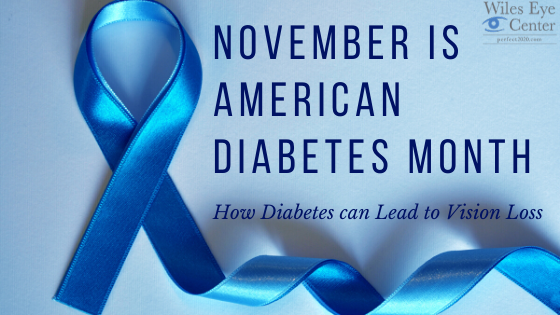
According to the Centers for Disease Control, more than 100 million adults in America are suffering from Diabetes or prediabetes*. This means that nearly 10% of the population suffers from this disease*. Out of these adults suffering from diabetes, 25% of them were unaware that they had diabetes*. Diabetes entails many symptoms, which include frequently urinating, being very hungry or thirsty, extreme fatigue, blurry vision, a slow healing process, abnormal weight loss, and tingling/numbness of the hands and feet*. In addition to many symptoms, diabetes also comes with many complications such as high blood pressure, increased risk of strokes, and nerve damage, but did you know that diabetes affects your vision as well?
Diabetic Eye Disease is a group of diseases that affect the vision of people suffering from Diabetes*. These diseases include Diabetic Retinopathy, Diabetic Macular Edema (DME), Cataracts, and Glaucoma*. Each type of disease comes with its own list of symptoms, risks, and treatment options. One thing all forms of Diabetic Eye Disease has in common is the risk for severe vision loss, and the potential to cause blindness. Because Diabetic Eye Disease is often unnoticed until vision loss occurs, it is recommended for those who suffer from Diabetes to receive a dilated eye exam at least once a year. You should consult your optometrist or ophthalmologist to discuss how often you need an eye exam. The most common form of Diabetic Eye Disease is Diabetic Retinopathy.
Diabetic Retinopathy is the most common cause of vision loss in people with Diabetes, and a leading cause of blindness among working-age adults*. Diabetic Retinopathy is a disease that affects tissues within the Retina that detect light. This is caused by chronically high blood sugar that causes damage to the blood vessels within the eye. Vision impairment can occur through the leaking of these blood vessels or overgrowth of blood vessels. Another common form of Diabetic Eye Disease is Diabetic Macular Edema (DME).
Diabetic Macular Edema (DME) occurs when fluid accumulates within the macula. The macula is responsible for sharp vision straight-ahead vision that is used when reading, recognizing faces, and driving*. DME is the most common cause of vision loss within people who suffer from Diabetic Retinopathy. Nearly 50% of those who suffer from Diabetic Retinopathy will develop DME*. Anyone who suffers from type 1 or type 2 diabetes are at risk for developing Diabetic Retinopathy, including women who suffer from Gestational Diabetes. Gestational Diabetes entails its own risk factors for Diabetic Eye Disease. It is often not caught in its early stages and is rapidly worsening. If you are diagnosed with gestational diabetes, it is always a good idea to have an eye exam, just to be safe.
Both Diabetic Retinopathy and Diabetic Macular Edema can be detected through a comprehensive dilated eye exam. During this exam, the eyes will be checked for signs of Diabetic Retinopathy or DME, such as leaking blood vessels, swelling of the Macula, changes of the lens or blood vessels, and damage to nerve tissue. Treatment for these conditions can include injections and/or laser surgery.
As for diet, there are foods that can help regulate blood sugar levels. These foods include berries, whole grains with a lot of fiber (such as oatmeal), avocado, cottage cheese, eggs, lean meats, and a variety of vegetables. By adding some of these foods to your diet, you can help control blood sugar and decrease the risk of complications that arise with diabetes. Another great way to control blood sugar levels is by choosing complex carbohydrates such as fruits, beans, lentils, and quinoa. Eating healthy snacks rich in fiber during the day can help control hunger and cravings. In addition to choosing healthier carbohydrates, you should offset the number of carbohydrates you’re eating by adding a lot of fresh, non-starchy vegetables, lean protein, and healthy fats. In addition to a healthy diet, daily exercise can help decrease the risk for Diabetic Eye Disease. Daily exercise can help prevent obesity, and reduce the risk of diabetes.
By controlling blood sugar, maintaining a healthy diet, and regular exercise, you will be able to help control your diabetes or prevent diabetes altogether. By controlling and preventing diabetes, you are protecting yourself from Diabetic Eye Disease. If you have any questions or would like to schedule an appointment, please call us. Our Kansas City location can be reached by calling 816-455-2020. You can reach our St. Joseph’s location at 816-279-7015.
*Attributions:
https://nei.nih.gov/health/diabetic/retinopathy
http://www.diabetes.org/diabetes-basics/symptoms/?loc=adm
https://www.cdc.gov/media/releases/2017/p0718-diabetes-report.html

Comments are closed here.